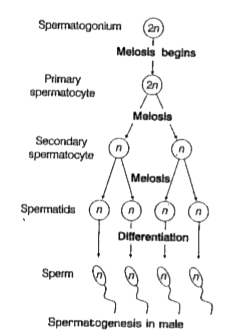With the help of a schematic labelled diagram, trace the development of mature spermatozoa in a human male.Solution in Odia
Spermatogenesis is the process of formation of spermatozoa (sperms) in the testes which originate from the Primordial Germ Cells (PGCs). The process of spermatogenesis initiates at puberty and continues even in old age.
It includes the following four stages
(i) Multiplication phase During this phase, the undifferentiated germ cells present in the seminiferous tubules of the testes known as spermatogonia or sperm mother cells increase in number by repeated mitotic divisions so that the newly formed spermatogonium possesses the same number of chromosomes.
(ii) Growth phase It gives rise to spermatocytes. Each spermatogonium accumulates large amount of nutrition and chromatin material. It is now known as primary spermatocyte which is diploid in number and contains . 46 chromosomes.

(iii) Maturation phase of formation of spermatids A primary spermatocyte undergoes first meiotic division leading to two equal haploid cells called secondary spermatocytes which contain only 23 chromosomes each .
The secondary spermatocytes undergo the second meiotic division to produce four equal haploid spermatids .
(iv) Differentiation phase The spermatids further are transformed into spermatozoa by the process called spermiogenesis .
During spermatogenesis , the germ cells are closely associated with Sortoli cells . Sperm heads become embedded in the Sertoli cells which provide mechanical support , protection and nourishment to the developing spermatozoa and are finally released from the seminiferous tubules by the process called spermiation .
Topper's Solved these Questions
- BOOK - ARIHANT PRAKASHANCHAPTER - HUMAN REPRODUCTIONEXERCISE - TOPIC -2- TOPIC TEST 210videos
HUMAN REPRODUCTION
- BOOK - ARIHANT PRAKASHANCHAPTER - HUMAN REPRODUCTIONEXERCISE - TOPIC -3- PRACTICE QUESTIONS EXAMS., TEXTBOOK.S & OTHER IMP. QUESTIONS (1 MARK QUESTIONS EXAMS. QUESTIONS)45videos
HUMAN REPRODUCTION
- BOOK - ARIHANT PRAKASHANCHAPTER - HUMAN REPRODUCTIONEXERCISE - TOPIC -2-PRACTICE QUESTIONS EXAMS., TEXTBOOK.S & OTHER IMP. QUESTIONS ( 3 1/2 MARK QUESTIONS EXAMS. QUESTIONS)4videos
HUMAN REPRODUCTION
- BOOK - ARIHANT PRAKASHANCHAPTER - HEREDITY AND VARIATIONEXERCISE - CHAPTER TEST20videos
HEREDITY AND VARIATION
- BOOK - ARIHANT PRAKASHANCHAPTER - IMPROVEMENT IN FOOD PRODUCTIONEXERCISE - CHPATER TEST19videos
IMPROVEMENT IN FOOD PRODUCTION
Similar Questions
In a mature sperm the mitochondria are persent in .
04:05View SolutionHuman embryo is protected by which cavity?
03:47View SolutionWrite short note on spermiogenesis.
06:09View SolutionMultiple alleles control the inheritance of . . . . in man
View SolutionDuring hybridisation, emasculated buds need to be ........
09:04View SolutionWith the help of a diagram, explain the structure of mature male gametophyte .
05:03View SolutionTrace the development of a megaspore mother cell of a flower into a mature ovule. Give a labelled diagram of the final stage.
View SolutionDraw a labeled diagram of male reproductive system.
10:06View SolutionWith the help of a neat and labelled diagram, describe the human male reproductive system.
08:43View SolutionDescribe the human male reproductive system with the help of a neat labelled diagram.
06:07View Solutiona. When and where does spermatogenesis in a human male begin to take place? b. With the help of schematic labelled diagrams, trace the development of mature spermatozoa in a human male? c. Describe the structure of a human sperm.
05:37View SolutionDraw a labelled diagram of a human male reproductive system.
05:23View SolutionDescribe the human male reproductive system with the help of a neat labelled diagram.
02:48View SolutionWith the help of a neat labelled diagram describe male reproductive system in human beings.
View Solution(a ) Trace the development of megaspore mother cell up to the formation of a mature embryo-sac in a flowering plant. (b) Draw a labelled diagram of the structure of mature dicot embryo.
04:32View Solution

